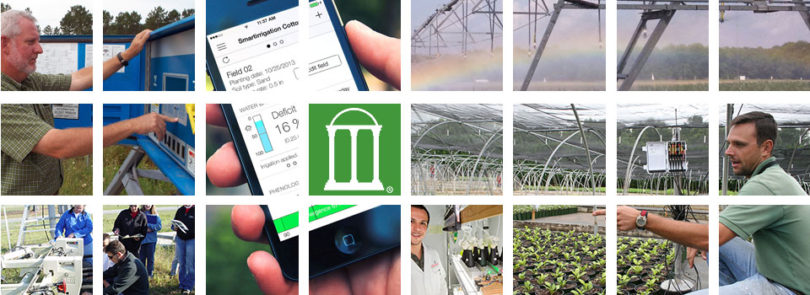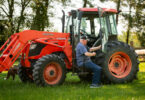For a burgeoning world population, precision agriculture and related agricultural technology will drive food security. The creative minds at the University of Georgia’s College of Agricultural and Environmental Sciences are researching and developing technology to enable farmers to feed the world’s growing population in a more sustainable fashion.
Using artificial intelligence, a new generation of remote sensors and state-of-the-art irrigation, lighting and fertilization equipment, researchers are demonstrating the possibility of growing greenhouse crops with up to 70 percent less water and about 50 percent less energy. They’re also developing systems that cut the need for fertilizers and chemicals in half.
The move to more precise, more efficient agricultural practices represents a new revolution in agriculture, one that will allow farmers to produce more food on the same amount of land with less water and fewer chemicals.
Irrigation catered to the thirst of each crop
Agriculture is responsible for the majority of water consumption in the U.S., accounting for more than 60 percent of the country’s freshwater use. As population growth increases demand-for water as well as food-growers are charged with making decisions that minimize water use and maximize yield through smart applications of fertilizer, fungicides and the like, all of which can be affected by irrigation.
CAES researchers are developing programs that use sensors to measure soil’s moisture content and monitor plants’ water needs to control irrigation systems. Some of these systems have cut water use by as much as 70 percent for some crops.
“Precision irrigation takes an imprecise practice (of guessing when plants need watering) and transitions it to what the plants specifically need-no more, no less. Until now, growers just used their judgment based on experience” to determine a plant’s irrigation needs, said Matthew Chappell, associate professor and UGA Extension nursery specialist, who works on precision irrigation in nursery settings.
He was one of the UGA researchers who, along with colleagues from the University of Maryland, Carnegie Mellon, Colorado State and Cornell universities, recently concluded a five-year project, funded by a $5.2 million grant from the U.S. Department of Agriculture’s Specialty Crop Research Initiative, to develop automated irrigation systems for nursery growers.
A test of the system at Evergreen Nursery in Statham reported a 70 percent reduction in water use in 2013. Another test of the system at McCorkle Nurseries in Dearing reduced losses credited to irrigation-related disease in the nursery’s 4 acres of gardenias from 30 percent to zero, shortened the plant’s production cycle from 14 to eight months and, consequently, decreased costs related to labor, fertilizer, fungicides and other inputs.
The $5,000 system paid for itself in less than a month, and McCorkle Nurseries increased profit by more than $348,000, Chappell said. The water saved at the nursery is enough to supply 2,000 people a day, said horticulture professor Marc van Iersel, who worked on this project.
Similar systems, which allow farmers to apply more precise irrigation to their fields, are being developed for row crop farmers as well. While the systems may differ, they all have the objective of applying the minimum required amount of water to keep crops healthy and productive.
The trick is that the precise amount of water needed by a crop can change wildly throughout one field, depending on topography and soil type.
Calvin Perry, public service faculty and superintendent of the college’s C.M. Stripling Irrigation Research Park, works with George Vellidis, a professor and precision agriculture expert on UGA’s Tifton campus, on various water-related research projects. Under Vellidis’ leadership, they developed a smartphone app to help cotton farmers water their crops based on local conditions, conserving water and money.
“There’s a continued need for precision irrigation because of global awareness of water limitations and competing demands for water in agriculture. In Georgia, there’s a growing awareness that irrigators need to up their efficiencies and improve their application methods,” Perry said.
The app pulls soil moisture information from sensors placed throughout the field and uses that information to make scheduling recommendations to the farmer.
Preston Jimmerson farms more than 2,000 acres of cotton and peanuts in Colquitt County, some of it on the edge of the Lower Flint River Basin. Jimmerson uses soil moisture sensors for some of his irrigation scheduling.
“The fields that we mainly use the soil moisture sensors on are about 15 miles from our base office. Being able to look on the computer in the morning and know what’s going on there rather than having to drive out-it’s a 30- to 45-minute round trip-really saves time. We can also see how much water is still in the soil, and sometimes we can hold off watering a day or two. It helps all the way around, and occasionally we’re able to skip a watering,” he said.
“Long-term, sustainable water resource management is critical to Georgia’s future, especially in agriculture,” said Casey Cox, project director of the state Flint River Soil and Water Conservation District. “It is vital that we work toward measures that conserve our natural resources for future generations. Precision irrigation is a tool that enhances water conservation as well as on-farm efficiency and decision making.”
Fine-tuned fertilizer
In addition to irrigation, college researchers, like Vellidis, are working with growers to find ways to better manage their farming operations, minimizing the amount of chemical inputs that farmers have to buy and use.
“If you’ve got a part of a field that’s not performing well, you can take the inputs you’re putting there and redistribute them to parts of a field that have higher yield potential. If you’ve got a cotton field, for example, where you have a patch that the best it’s ever going to do is one bale of cotton, and you’ve got another part of a field that can do three-bale cotton, you can take your nutrients and put them over there,” Vellidis said.
Vellidis describes “precision agriculture” as using data from the field in the form of maps in conjunction with agronomic knowledge and information to manage the variability within fields, which could be caused by soil types, different elevations or water availability. Precision agriculture involves using technology to optimize the distribution of inputs-such as nitrogen, plant growth regulators and defoliants-in a field. One such way is the use of optical sensors to collect information on plant health. With a designated algorithm, the data can be used to indicate which plants need which levels of nitrogen based on their foliage color or size.
Precision agriculture practices result in increased yields and a reduction in the agricultural inputs being used and improved environmental sustainability. Practices like these also increase farm efficiency, and profitability per acre could result, Vellidis points out.
Plants in control
In addition to finely tuning farmers’ use of water and agricultural chemicals, college researchers have also developed sensor systems that can provide indoor plants just the right amount of light at the right time, saving on energy costs.
Horticultural lighting company PhytoSynthetix, housed at UGA and co-founded by UGA graduate Erico Mattos, is using a biofeedback system to slash the amount of energy needed to produce a crop indoors.
“In 30 years, feeding about 9 billion people is going to be hard because we live on a planet with a fixed amount of land,” he said. “We have to increase food production. Moving food production indoors and to urban centers means no transport, shipping or handling costs. The yield is higher because the crop isn’t prone to rain, drought or disease. The one cost-prohibitive problem is energy consumption because of lights.”
His system uses plant-mounted sensors to predict the changing light needs of each plant and cycles the lights on and off to meet those needs without wasting energy.
“In plant factories, lighting costs are huge,” said van Iersel, who collaborated with Mattos on the project. “They’re popping up all over the country with little information on how to grow plants well. You know, there’s a reason we grow plants outside. We are very bad at judging how much light a plant needs.”
The PhytoSynthetix biofeedback system reads the plant’s chlorophyll fluorescence, the tiny amount of light re-emitted by chlorophyll molecules as they complete photosynthesis. If the plant is receiving more light than is needed, the system adjusts them. The plant is adjusting its own light, changing not only whether the light is on or off, but also the intensity of the light, the frequency of bursts of light and how long those bursts last.
Mattos expects commercialization of his full-spectrum light to be available in spring, and the automated system by the end of 2015. Measuring chlorophyll fluorescence isn’t new, and the fluorometer-the instrument used to make this measurement-is quite expensive. But Mattos and his team have developed a more affordable fluorometer that will cost growers around $150.






